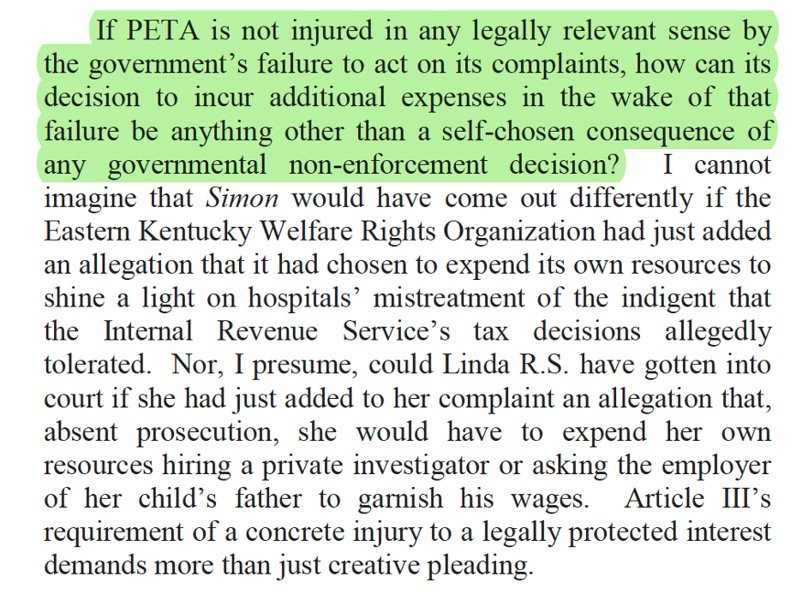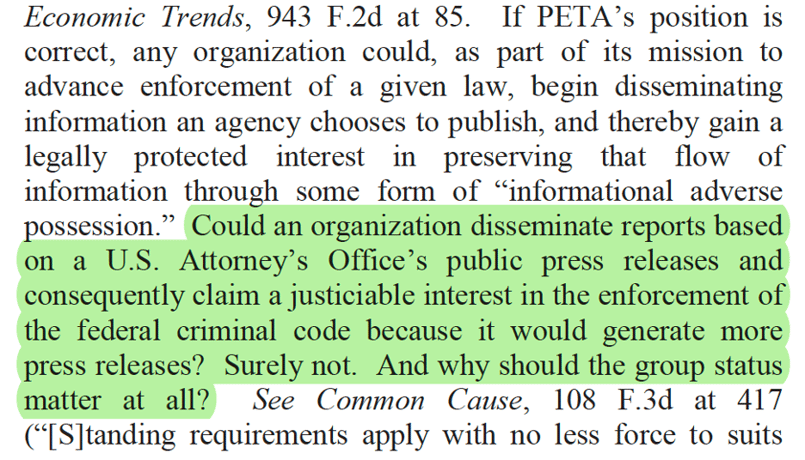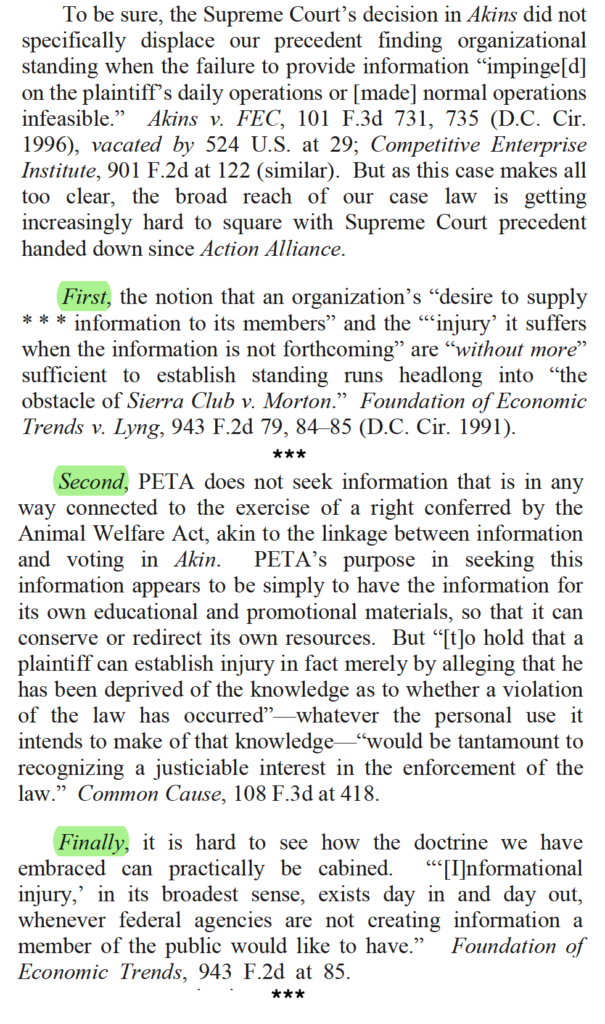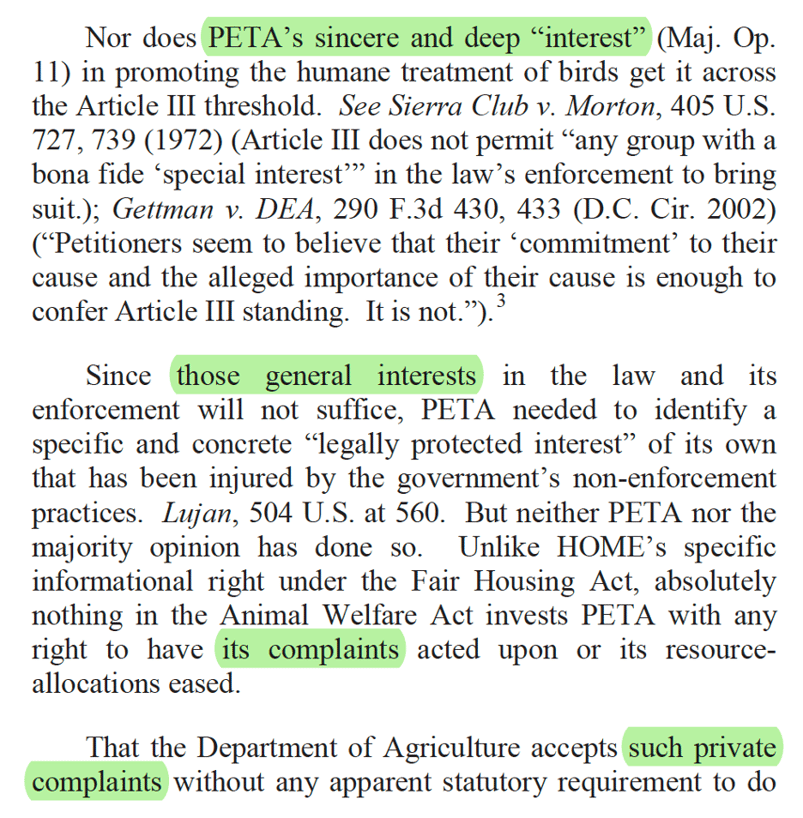Five Ways to Write Like D.C. Circuit Judge Patricia Millett
I often tell lawyers to purge their writing of Latinisms: why say “inter alia” when “among other things” would do, or “assuming arguendo” when you mean “even if”? But there are exceptions to every rule, as Judge Patricia Millett of the D.C. Circuit shows us with her dubitante opinion in People for the Ethical Treatment of Animals v. Department of Agriculture.
 The dubitante (literally “doubting”) opinion, a delightful but seldom used species of concurrence, signals that the author has joined an opinion that she doesn’t really believe in, usually because of bad precedent. Judge Millett’s PETA opinion captures the spirit of the form perfectly: while showing proper respect for stare decisis (oops, there’s another one), she casts serious doubt on the doctrine of organizational standing—and she does so with impeccable style.
The dubitante (literally “doubting”) opinion, a delightful but seldom used species of concurrence, signals that the author has joined an opinion that she doesn’t really believe in, usually because of bad precedent. Judge Millett’s PETA opinion captures the spirit of the form perfectly: while showing proper respect for stare decisis (oops, there’s another one), she casts serious doubt on the doctrine of organizational standing—and she does so with impeccable style.
No matter what you’re writing, you can turn to Judge Millett for examples on everything from tone to punctuation.
As a sampler, take these five techniques from her opinion:
1. Talk to Yourself—Ask a Rhetorical Question
Administrative law isn’t known for edge-of-the-seat drama, but when the bulk of your docket deals with agency actions, you find ways to make it interesting. Here, the D.C. Circuit had to decide whether PETA could sue the USDA for failing to implement animal-welfare regulations for birds. Precedent left Judge Millett no choice but to concur in the Court’s holding that PETA did indeed have standing to sue. But she filed a separate dubitante opinion urging her colleagues to revisit the case law. And what better way to call the doctrine of organizational standing into question than by posing some questions of her own?

Judge Millett shows us how the right rhetorical question puts the reader on the defensive. Unless you can answer her query, you have no choice but to agree with her conclusion: it’s time for organizational standing to fly the coop.
And later in the same opinion, Judge Millett masterfully combines the rhetorical question with the art of the analogy:

Instead of stating her position flat-out, Judge Millett invites us to consider how absurd organizational standing would be if taken to its logical limits. She sets up the shot and then puts the ball in her reader’s court.
2. Sound Off—Number Your Reasons

Legal readers don’t like to be blindsided: the more signposts you can plant, the better. One of the most effective—and fortunately, simplest—cues is the ordinal list. First, sum up your conclusion in a sentence or two, and then separate your reasons into numbered paragraphs. Here, Judge Millett tells us that the D.C. Circuit’s case law is straying too far from the Supreme Court’s guidance, and then she lists three reasons why she’s right:

Judge Millett’s choice to italicize her signposts enhances the sense of order. You can do the same, or you can experiment with boldface, numerals, or bullets. Remember: you’re directing traffic. If you want people to follow you to your destination, you should make it as easy as possible to get there.
3. A Dash of Style—Punctuate Your Points
Like a dramatic pause in speech, a pair of interruptive dashes draws attention to a particular phrase or idea. It also has an impressive range of rhetorical flexibility. As Judge Millett shows us here, dashes are just as good for driving home your point as for casting doubt on your opponent’s:

Judge Millett’s paired dashes are a little like buoys on a lake: when you get close to them, you know you need to slow down and pay attention to what’s in the middle. Dashes aren’t just for rhetorical flourishes, though. In one of their more workday guises, they’re an economical way to define a term, as in this excerpt from the majority opinion:

4. Bridge the Gap—Use Logical Connectors Between Paragraphs
In Bryan Garner’s typology, there are three ways to bridge from one paragraph to the next: (1) metalanguage like “next” or “in sum”; (2) pointing words like “these” or “this”; and (3) subtle paraphrases, sometimes called “echo links,” of the immediately preceding idea. The third technique is the hardest to master, and Judge Millett is a virtuoso. Here she connects not two but three paragraphs:

Note that the second paragraph opens with an echo of the “interests” discussed in the first paragraph and ends with a preview of the next paragraph’s subject: complaints. These links make Judge Millett’s argument effortless to follow while giving the reader a bird’s-eye view of the opinion’s logical structure.
5. End with a Bang—Leave the Reader with an Image They Won’t Forget
Analogy is the spice of legal writing. In fact, choosing the right comparison can frame the whole case in your favor. Say you want to characterize a nonprofit like PETA that seeks to compel agency action based on its general interest in animal welfare. These groups asserting organizational standing are a bit like vigilantes taking the law into their own hands, no?
A good writer might have stopped there, but a great writer like Judge Millett takes it one step further, closing her opinion with a clever pop-culture allusion:
By placing her hypothetical vigilantes in the Marvel universe and grafting them onto popular characters, Judge Millett creates an unforgettable image. Whether you like it or not, the next time you hear “organizational standing,” you’ll think of the Justice League.
Incorporate these five techniques into your next brief or memo, and you’ll be well on your way to writing like Judge Millett.
 By
By



